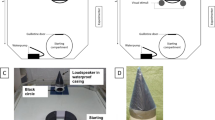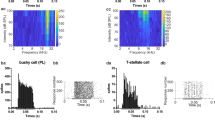Abstract
Kritzler and Wood1 succeeded recently in training a bull shark (Carcharhinus leucas) to respond to sine-wave sound signals emitted from a submerged loudspeaker. Responses occurred to frequencies between 100 and 1,500 c.p.s. A threshold curve shows that the animal was most sensitive to frequencies of 400–600 c.p.s. The sound source was (acoustically or visually) localized.
This is a preview of subscription content, access via your institution
Access options
Subscribe to this journal
Receive 51 print issues and online access
$199.00 per year
only $3.90 per issue
Buy this article
- Purchase on Springer Link
- Instant access to full article PDF
Prices may be subject to local taxes which are calculated during checkout
Similar content being viewed by others
References
Kritzler, H., and Wood, L., Science, 133, 1480 (1961).
Dijkgraaf, S., Biol. Rev., 38 (in the press).
Dijkgraaf, S., Proc. Roy. Soc., B, 152, 51 (1960).
Lowenstein, O., and Roberts, T. D. M., J. Physiol., 114, 471 (1951).
Vilstrup, T., Structure and Function of the Membranous Sacs of the Labyrinth in Acanthias vulgaris (E. Munksgaard, Copenhagen, 1951).
Parker, G. H., Science, 29, 428 (1909).
Dijkgraaf, S., Z. vergl. Physiol., 34, 104 (1952).
Author information
Authors and Affiliations
Rights and permissions
About this article
Cite this article
DIJKGRAAF, S. Sound Reception in the Dogfish. Nature 197, 93–94 (1963). https://doi.org/10.1038/197093a0
Issue Date:
DOI: https://doi.org/10.1038/197093a0
This article is cited by
-
Peripheral auditory physiology in the lemon shark: Evidence of parallel otolithic and non-otolithic sound detection
Journal of Comparative Physiology ? A (1981)
-
Acoustic evoked activity in the brain in sharks
Journal of Comparative Physiology A (1979)
-
Das H�rverm�gen des Kaulbarsches (Acerina cernua L.) und des Zanders (Lucioperca sandra Cuv. und Val.)
Zeitschrift f�r Vergleichende Physiologie (1968)
Comments
By submitting a comment you agree to abide by our Terms and Community Guidelines. If you find something abusive or that does not comply with our terms or guidelines please flag it as inappropriate.



